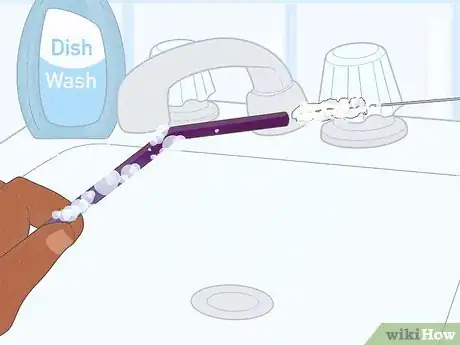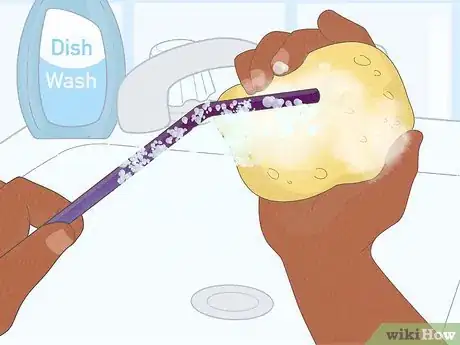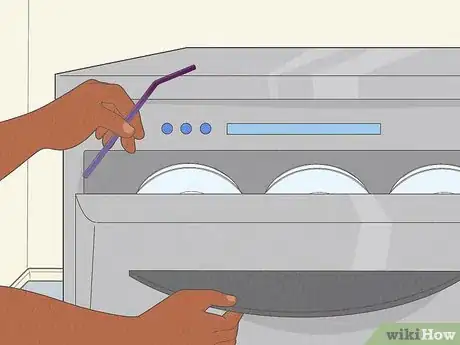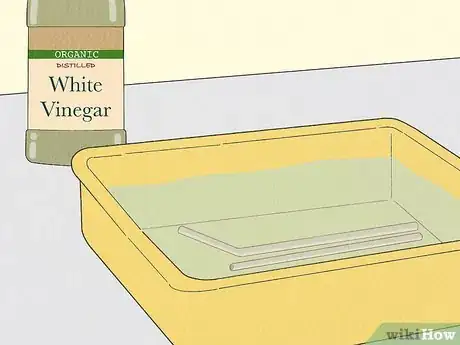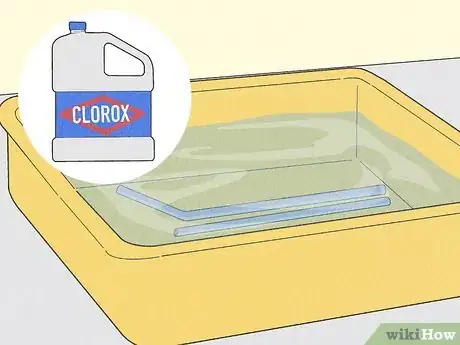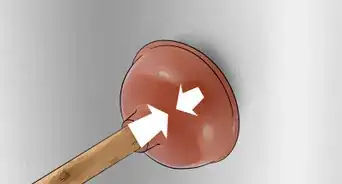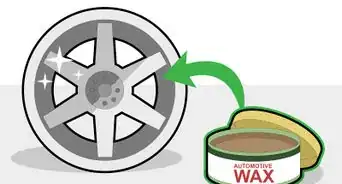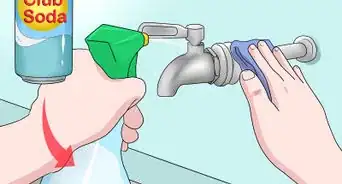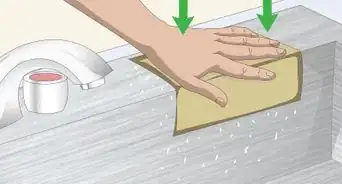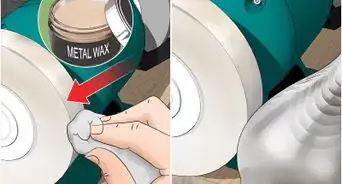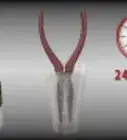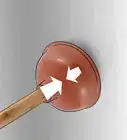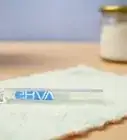This article was co-authored by Regina DeCorte and by wikiHow staff writer, Eric McClure. Regina DeCorte is a Residential Cleaning Specialist and is the Founder of Maid in JC, a home cleaning service based in downtown Jersey City, NJ. With more than eight years of experience, she specializes in cleaning apartments, condos, and townhomes using natural products. Regina and her staff are fully bonded and insured.
This article has been viewed 17,084 times.
Reusable metal straws are a great alternative to plastic straws. They’re also much easier to recycle when it comes time to discard them. Unfortunately, they can be kind of tricky to clean since it’s hard to scrub the interior of the straw, and many metal straws are not dishwasher safe. Keep in mind, metal straws are more likely to hold on to dust and dirt than their plastic counterparts, so always rinse your straw in water before dipping it into a fresh beverage.
Steps
Performing a Basic Cleaning
-
1Rinse out your straw immediately after every use to keep it clean. Rinsing your straw right away prevents residue from building up on on the inside. Hold the straw under a warm stream of tap water and let the water run inside of the straw for about a minute.[1]
- Typically, a simple rinse under a stream of warm water is more than enough to clean your straw. However, if you don’t rinse the straw after using it, you may need to use soap or another cleaning method.
-
2Scrub the inside of the straw with a bottle brush, soap, and water. Squirt a little dish soap on the bottle brush or pipe cleaner and run it through the middle of the straw while rinsing it. Do this for 30-45 seconds to completely clean the inside.[2]
- Some higher-end metal straws come with a brush designed specifically to clean the inside of the straw.[3]
- If you have a bent metal straw, be sure to use a flexible brush or pipe cleaner.
Advertisement -
3Wash the exterior of the straw using dish soap and water. Squirt a small dollop of dish soap into a sponge and load it up with water. Then, run the surface of the sponge over the exterior side of the straw. You can also brush the exterior of the straw with your pipe cleaner or bottle brush.[4]
- It’s pretty easy to clean the outside portion of the straw. So long as it is lathered in soap, it doesn’t really matter how you clean it.
-
4Put the straw in your dishwasher if the manufacturer says it’s safe. Some metal straws will rust over time if they’re placed in the dishwasher. However, if the company that made your straw says that it is dishwasher safe, place the straw vertically in the silverware basket and wash it with the rest of your dishes.[5]
- Check the packaging on your metal straw or consult the manufacturer’s website to find out if you can wash your straw in the dishwasher.
Warning: If you aren’t sure if your straw is dishwasher safe, don’t take the risk of washing it. If the inside of the straw gets rusty, you could end up ingesting rust particles. It probably won’t be enough to cause any serious harm, but it will at least ruin the taste of whatever you’re drinking.
-
5Soak the straw in soapy water for 15-30 minutes if it’s especially dirty. Squirt 4-5 drops of dish soap into a bowl of warm water. Mix the water and soap together and drop the straw in. Let it soak before taking it out of the water and scrubbing the inside with a pipe cleaner or bottle brush. Rinse off the soap before letting the straw air dry.[6]
-
6Wipe the straw with a disinfectant wipe if it’s sticky. If there are oils or sticky residues stuck to your straw, grab a disinfectant wipe. Wrap the wipe around the affected area and scrub the straw by moving the wipe up and down for 10-20 seconds. Then, wash your straw the same way that you normally do with soap and water to remove any residue from the disinfectant wipe.[7]
- If you don’t wash the straw after wiping it, your beverage may taste like nasty chemicals the next time that you use it.
- If the stickiness is inside of your straw too, rub the disinfectant wipe on your pipe or brush cleaner and run it through the center of the straw. If you don't have a pipe cleaner, then you can use a cotton swab or a long, dry pasta noodle to clear obstructions.
Sterilizing and Removing Gunk
-
1Soak the straw in boiling water for 3-5 minutes to sanitize it. Fill a small pot with water and turn the heat on high. Once your pot reaches a rolling boil, drop the straw into the water. Let it sit in the boiling water for 3-5 minutes. Then, use a pair of tongs to pull the straw out and hold it under cold water to cool it off.
- Your straw should handle the hot water just fine, but you may want to boil it for a shorter period of time if it’s a cheaper, thinner straw.
- Wash your straw with soap and water after you sanitize it.
-
2Deodorize the metal straw in a vinegar and water mixture for 10 minutes. Mix 1-part white vinegar and 1-part water in a bowl. Drop your straw into the bowl and let it sit. After 10 minutes have passed, use tongs or put on a pair of gloves and lift the straw out of the vinegar and water. Then, rinse the straw under warm water to remove any residue and remove the smell of the vinegar.
- Add a small amount of baking soda and lemon juice to the white vinegar if your straw is smelling particularly nasty.
-
3Soak the straw in bleach and cool water to completely kill bacteria. If you’re concerned about bacteria and diseases, fill a bowl with 1 US gal (3,800 mL) of cool water. Then, add 1 US tbsp (15 mL) of chlorine bleach. Drop the straw into the cleaning solution and let it soak for 1-5 minutes. Then, remove your straw and rinse it with water to remove the bleach. Let the straw air dry.[8]
Community Q&A
-
QuestionI don't want to remove the bleach. Can I leave it on there?Bleach is strong stuff. It is not good for your health to breathe or drink it, and it's not good for metal to leave it in contact for a long time. It's best to rinse and dry the straw rather than leave bleach residue in contact. The straw will be well sanitized after the soak.
Things You’ll Need
Washing Your Straw
- Water
- Pipe cleaner or bottle brush
- Dish soap
- Towel
- Disinfectant wipe
Removing Gunk and Sterilizing
- White vinegar
- Water
- Towel
- Pot
- Tongs
- Bleach
- Baking soda (optional)
- Lemon juice (optional)
References
- ↑ https://parade.com/925115/rachelchang/clean-metal-straw-tips/
- ↑ https://www.cleaninginstitute.org/cleaning-tips/clean-home/ask-aci/ask-aci-how-clean-metal-straws
- ↑ https://nymag.com/strategist/article/best-metal-straws-review.html
- ↑ https://www.cleaninginstitute.org/cleaning-tips/clean-home/ask-aci/ask-aci-how-clean-metal-straws
- ↑ https://www.today.com/series/one-small-thing/we-tried-these-stainless-steel-straws-3-800-amazon-reviews-t132075
- ↑ https://www.steelystraws.com/learn/how-to-clean-stainless-steel-drinking-straws/cleaning-straws-at-restaurant/
- ↑ https://parade.com/925115/rachelchang/clean-metal-straw-tips/
- ↑ https://stopfoodborneillness.org/news-from-stop-clean-sanitize-disinfect/
- ↑ https://parade.com/925115/rachelchang/clean-metal-straw-tips/

